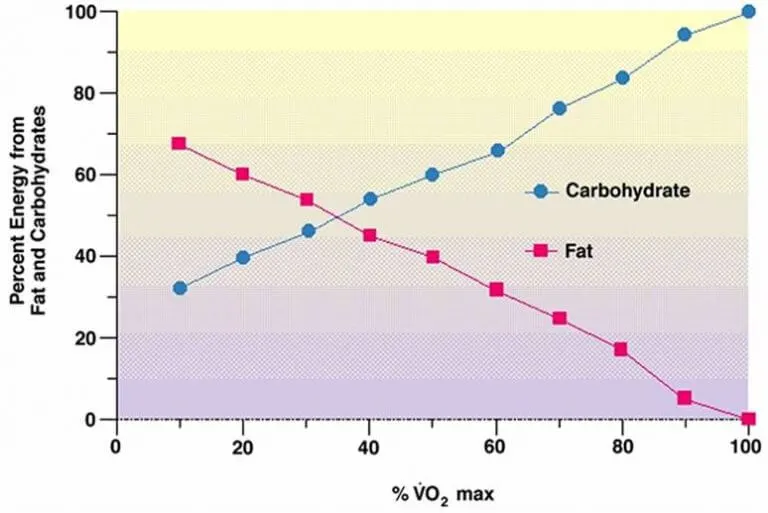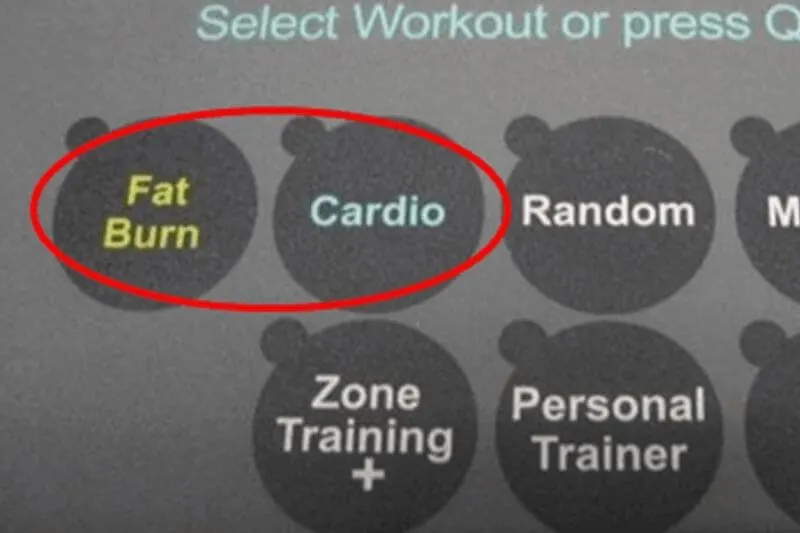Yearn for the fat burn! But do those “fat burn” buttons on exercise machines really live up to their names? What about the cardio button?
Seems pretty straight forward, right?
You push the fat burn button and voila! The fat melts away.
Push the cardio button and you build a ticker like a thoroughbred racehorse.
Uh, yeah right…good luck with that.
So what’s the deal? Will the fat burn button eject that junk from your trunk?
And will the cardio button give the Tin Man a heart?
Well, the answer is – it depends. Let’s have a closer look.
High intensity vs. low intensity exercise?
In exercise physiology, we have something known as the Respiratory Exchange Ratio (or RER).
This is where we measure your expired carbon dioxide and inspired oxygen in a laboratory.
The ratio gives us an indication of how much fat or carbohydrate you’re using as a fuel source at a given intensity.

In general, lower exercise intensities use more fat and higher intensities use more carbohydrate (glucose).
The energy substrate chart illustrates this principle.
That’s what happens in the lab, but how does it translate to losing stored body fat in the gym and looking great for that class reunion?
Here’s where it gets tricky so pay attention.
While there are numerous factors which impact your ability to lose weight, still, at the end of the day, it is ultimately a numbers game.
If you burn off more calories (kJ) than you consume, you will lose weight.
Eat more calories than you burn off and you gain weight.
I jokingly tell my exercise physiology students to tell their clients, “use the fat burn button if you want to stay fat. Use the cardio button if you want to lose fat.”
“Fat burn” vs. “Cardio” exercise per unit of time: the smoking gun
Generally speaking, a higher intensity sustained for a longer duration will best maximise energy expenditure, resulting in a greater calorie (kJ) deficit, and more likely lead to the most weight loss “bang for the buck.”
For example, walking on a treadmill at 1 mph (1.6 kmh) for 10 minutes (low intensity) will use proportionally more fat as a fuel source.
But the trade-off is that it will burn comparatively fewer overall calories (kJ) than walking on a treadmill at 5 mph (8 kmh) for 10 minutes.
The latter 5mph (8 kph) is higher intensity and will use proportionally more glucose as a fuel source BUT, more importantly, will also maximise the overall calorie (kJ) expenditure PER UNIT OF TIME and lead to the greatest caloric deficit.
So the take home message from the above discussion is that, to maximize fat loss, you need to work out at higher intensities for longer durations.
But WAIT, there’s more!
Don’t go anywhere yet! That’s not the end of the story.
You might be scratching your head saying, “well heck, I haven’t exercised in 30 years. I can’t do high intensities yet. I get short of breath just walking to the mailbox.”
Establish your fitness foundation
You need to ease into exercise.
Even if you can only do a few minutes at a time at a very low intensity, this is still a good thing.
Do what is known as interval training.
You do short bouts of activity with little rest periods in between.
Then gradually wean your way onto longer, more continuous durations while reducing the number of exercise bouts.
Fat burning interval training
Once you have your fitness foundation in place, then you can to start challenging yourself to do higher intensities.
For example, if you’re doing a 30 minute continuous walk at a moderate pace, then try interspersing short 1-2 minute intervals at a higher intensity.
After your intervals, slow down to your previous speed and use this as an active recovery.
When you’re ready again, add in another interval.
Your goal is to walk at the highest intensity that you can sustain for a given period of time.
Bottom line on fat burn vs cardio buttons
When it comes to the fat loss game, forget the exercise equipment fat burn and cardio buttons.
I suggest using a manual setting so you can customise the workloads to your individual fitness needs.
Work your way to the higher intensities as appropriate and then hold it there for a while.
In the grand scheme of things, forget about which fuel source you’re using.
The key is to maximise your energy deficit.
While everyone is looking for the secret to permanent fat loss, the secret is that there is no secret.
You still have to eat less, move more (perhaps add in some resistance training), and remain consistent in your efforts.

Dr. Bill,
Another GREAT Post. With your permission I would like to print this and distribute it to my staff and clients at Vertex Fitness.
Keep the great information coming.
Dwayne Wimmer
Owner
Vertex Fitness Personal Training Studio.
Heya Dwayne,
With pleasure. Perhaps just make sure there’s a link to the site so they know the source (and where to visit if they feel so inspired). Thanks for your support, amigo. Hope all’s well back at the Vertex mother ship!
Cheers bud,
Bill
Since we burn greater percentages of fat at lower intensities of activity, I often tell people that this means that sleeping burns the most fat!
Excellent post Bill!!
This is spot on. Last year I dropped 40 pounds by reducing my caloric intake by about 500 calories per day and increasing my cycling from 50-100 miles per week to 100-200 miles per week. During my rides I introduced interval training and I am sure it helped immensely. Now, due to a diagnosis of A-fib and SVT, I can no longer do the long rides but I go into my gym and do weight and cardio for about 1.5 hours five times a week. At the end of my cardio, three times per week, I do a Tabata Interval on the spin bike. I think the intervals are the most important thing one can introduce into their workouts.
Thank you Dr. Bill! This website is great. Looking forward to more great articles from you!
Very interesting read. Why is it more important to burn more calories vs. using more fat as a source?
And also what is considered a long duration? How long is long enough for someone to lose weight? I have a friend who thinks she needs to work out for 3+ hours at a time.
Thanks for the great articles; I’m learning so much! Keep it up!
The fuel source during exercise isn’t necessarily THE most important factor since if you create a calorie deficit from exercise, your body will eventually pull fat out of storage to justify the difference. Three hours is probably overkill, but an hour or so would be considered long duration compared to just a quick 5 or 10 minute warm up on the bike.
I am a 230lb 5’7 Woman who recently bought a fit band to help motivate myself. Over the past week, I walked 6 of 7 days, walking 2.15 miles at minimum at an average of 18.20 mpm. I was careful to eat properly and cut out sugar. To my dismay I lost no weight, actually gaining 2lbs! What is happening?
You’re not going to see large changes in body composition in just one week. By starting exercise, you likely increased your weight due to storing carbohydrate in your muscles (called glycogen). You also would have some water bound to that glycogen. So while you increased in scale weight, it’s unlikely that you put on fat. Keep up with your exercise and in time you’ll see a decrease in both your body fat and scale weight.
I am almost 69 and walk 3 to 6 miles per day in high desert terrain on a dirt road with some elevation change and levelness change. I average 3.3 mph. At times the temp. is at least 95 F. So far this month I have gone about 50 miles. Am I risking my health doing this intensity? I am 5’7″ and about 200 lbs. I have done this off and on for about 3 years with no injuries other than sore feet.
Hi Charles,
Thank you for your comment. Based on what you’ve provided, you appear to be both acclimatised to the current temperatures in which you’re exercising and reasonably trained (accustomed) to your current walking speed of 3.3 mph. I think your main concerns would be to ensure that you: 1) are properly hydrated and fueled before exercise; 2) carry sufficient water with you while on your walks; and 3) pay attention to any changes in your environment (re: sudden temperature changes, weather, etc). Assuming no underlying medical issues which might be worsened by the heat, then I’d imagine you’d be ok to carry on with your current exercise routine. Hope this helps. Keep up the good work.
I am definitely going to be doing A TON of HIIT workouts! I love them since they are so quick, but so effective at the same time. Thanks so much for your post Bill!
Thanks for sharing. Your posts are always spot on. Shame the truth doesn’t go viral and get thousands of likes and shares like the quick fix products and diets. I sometimes think people don’t want to hear the truth as losing weight takes hard work and determination.
Lisa